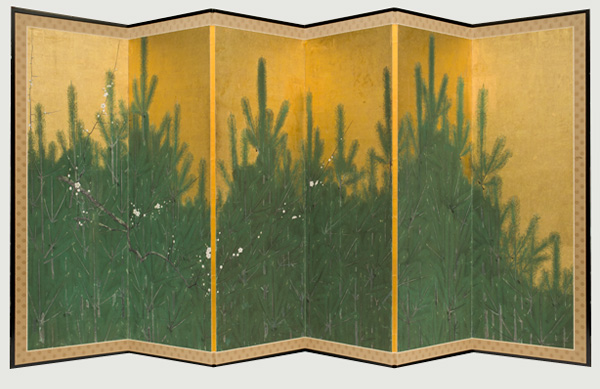
January 23 - May 3, 2015
Japanese Gallery
Above: Kano̅ School, Edo period (1615-1868), early to mid-17th century; Six-panel folding screen; mineral pigments, ink, and gold leaf on paper; Stoddard Acquisition Fund, 2012.97
This rare screen from the 1600s is superbly representative of the sophisticated elegance, energy and sumptuousness that appealed to Japanese noblemen and feudal lords. Created for display in a dimly-lit room in a castle at New Year's, the screen features two enduring symbols of the new year set against a gold background: dark, hardy evergreen pines, emblems of long life, dignity and power, and delicate white plum blossoms, the first flowers of the lunar calendar year, symbolic of new life.
During the 15th and early 16th centuries, Kano̅ school artists were often commissioned by Zen abbots and feudal warlords to produce monochrome ink paintings of, for example, Chinese landscapes with scholars or tiger and dragon motifs. However, starting in the late 1500s, Kano̅ Eitoku (1543-1590) and his students dramatized and expanded the Kano̅ school repertoire. During the peaceful Edo period (1615-1868), when wealthy merchants also began to commission screens, Kano̅ school artists freely merged ink brushwork with the bright colors, patterning and seasonal references associated with native Japanese tastes. In this screen, linear vertical and diagonal branches and soft pine boughs contrast with an undulating branch of white plum blossoms that dramatically winds across the screen surface.

 Sign up for WAM eNews
Sign up for WAM eNews